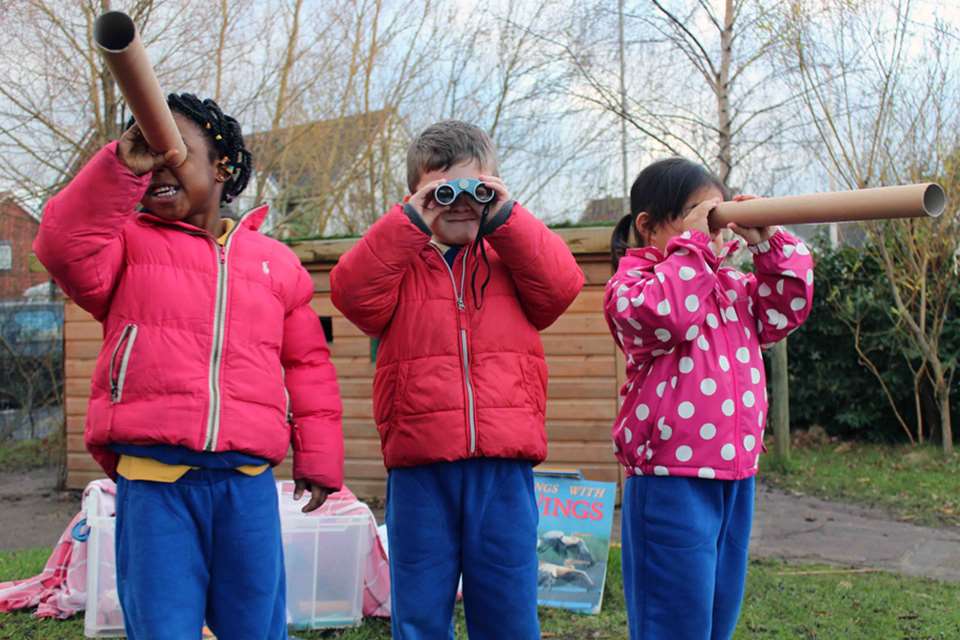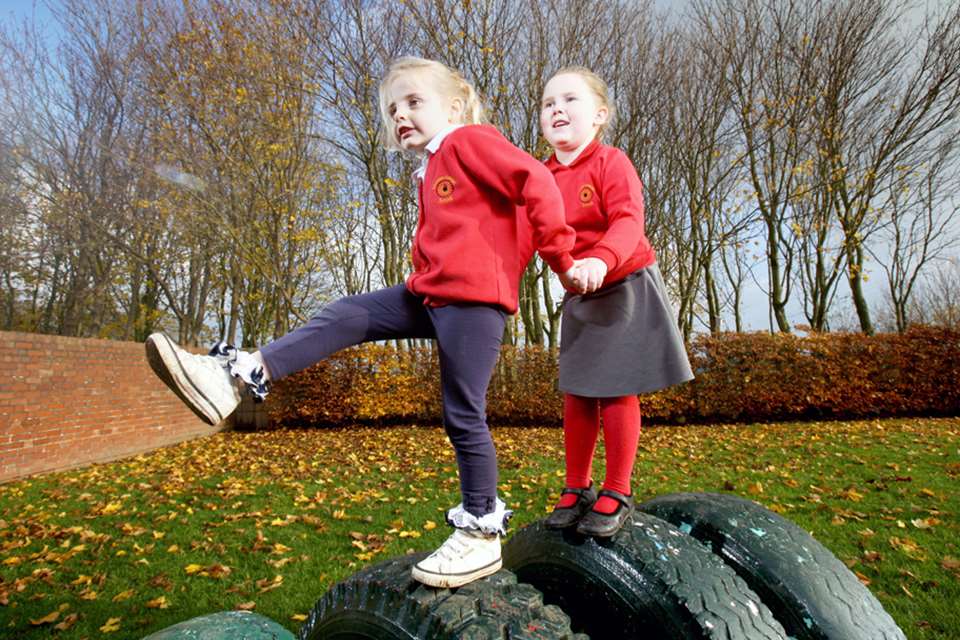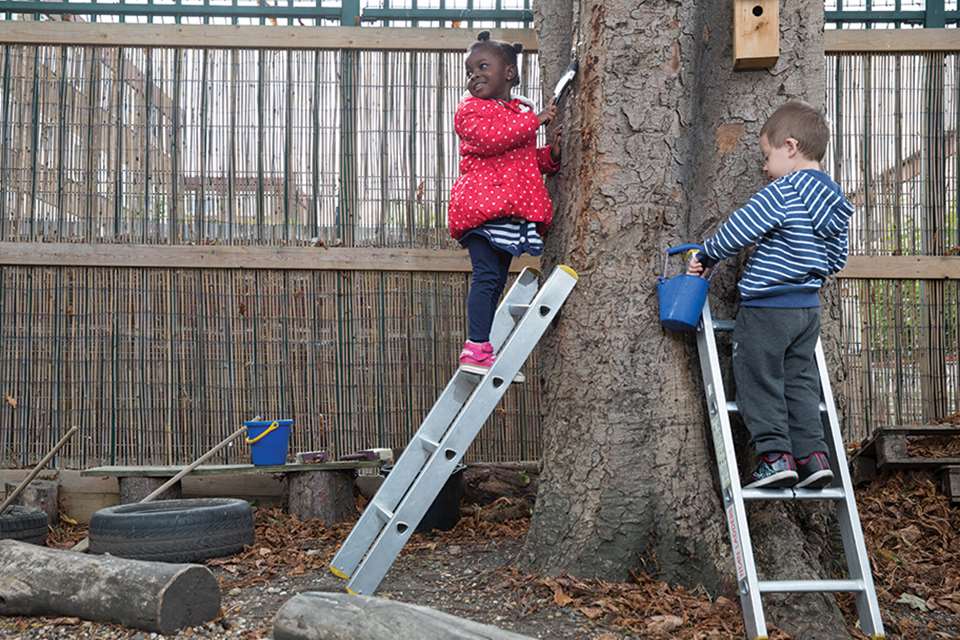Enabling Environments: Outdoors - Passing it on
Julie Mountain
Monday, November 14, 2016
In the third part of her series on Newham’s Outdoors and Active programme, Julie Mountain finds out how it has involved parents and carers to create a family culture of movement and physicality

While there is much that qualified, experienced and professional early years teams can do to improve children’s health and well-being through movement, long-term changes will only be sustained where there is a well-established culture of physical activity. It’s therefore vital that families and carers understand the role that movement and physicality have in children’s health, well-being and cognition, and are equipped to promote movement-based outdoor play beyond the setting.
Education professionals have long understood the connection between physical and neurological development. What’s less clear is how much parents and carers understand. The phrase ‘children don’t come with instructions’ is often heard but, in fact, for early years practitioners, they do come with instructions in the form of training, continuing professional development, peer mentoring and experience. The trick is sharing this knowledge and expertise with parents in a way that will motivate them to continue the good work.
The childminding co-ordinators and childminders in the Outdoors and Active project based their action research on this conundrum, collaborating to support one another, but each approaching it in a contrasting way in order to maximise the value of the research. In carrying out their projects, they also sought to find ways to influence parents and carers, with the aim of embedding a culture of movement and physicality into family life.
WHAT ARE THE BENEFITS FOR FAMILIES?
Recent academic research by Dr Mike Rogerson and the Green Exercise team at the University of Essex indicates that outdoor exercise has greater benefits than indoor exercise: people are more motivated to continue to exercise, they enjoy it more at the time, and they talk more when outdoors.
Green Exercise research also suggests that there is a positive effect on self-esteem, and stress levels, possibly because the social interactions that are possible outdoors make the activity more attractive. These preliminary findings also echo the work of Dr Ferre Laevers in establishing the link between engagement and well-being in young children.
Where families play and exercise together, strong bonds are formed. Where children see their parents and carers playing, they recognise play as valuable and something to be shared and nurtured. While it’s important for children to be given the freedom and time to play independently and without interruption, adults modelling playfully active behaviour alongside children sends convincing messages to them about physical fitness and activity being a vital part of a healthy, happy, comfortable life.
WHAT CAN SETTINGS DO?
Newham’s childminding co-ordinators work from hub children’s centres across the borough, with a remit that includes bringing childminders and families into the children’s centres to access services and use the outdoor facilities. As part of their action research projects, they tried different ways of educating parents and carers about the importance of physically active outdoor play. In addition to inspiring parents to be more active themselves, a key objective was to make it as simple as possible to maintain a more active family lifestyle. Here are some of the childminding co-ordinators’ recommendations:
• Implement a Fitness Friday. Start each Friday with a 15-minute active outdoor play session for children and their carers, focusing on big movements and collaboration. Play alongside your children to model playful activity for parents and carers, using whatever features and resources you have. Settings that start their day with outdoor play, rather than indoor activities, often report positive benefits to children’s behaviour, well-being and energy.
• Create a lending library of Physicality Grab and Go kits. The kits should be simple, cheap, in different types of container and easily replenished, so that families don’t worry about losing items. Weekend or holiday loans will give parents and childminders an opportunity to try the resources out for themselves, before sourcing their own (see box for content ideas).
• Go on regular expeditions to local parks. Photograph the children as they use the park features, furniture, planting and play equipment in innovative ways, and share these with parents and carers so they can replicate the activities with their children. Seeing evidence of their brave, strong, risk-taking children enjoying and stretching their bodies is a key way of building confidence in parents and carers, making them more likely to maintain an active lifestyle.
• Provide families with activity prompts – based on Jasmine Pasch’s Boing Whoosh RolyPoly approach. One suggestion was to share prompts on a Friday afternoon – for example, ‘Top Ten Ways to Whoosh this Weekend’ – and to ask parents to share what they did with their children the following week.
• Host regular but brief parent and carer meetings – focusing on different elements of children’s development. Make a strong case for whole-body movement, physicality and ‘bodyfulness’ as non-negotiable in order to achieve goals that parents do understand: school-readiness, and that aspirational tripod grip.
CASE STUDY
Sally King works from Oliver Thomas Children’s Centre in Newham and is responsible for supporting childminders and families in the centre’s catchment. A self-described ‘outdoorsy person’ herself, Sally embraced the Outdoors and Active programme and set out to find out what she could do to make a tangible and lasting difference to the amount of physical activity that minded children were achieving.
She tested a variety of interventions with her childminders and their minded children, starting with an information workshop for childminders to convey the importance of outdoor play, introduce the Boing Whoosh RolyPoly approach, explore the benefits of risk-taking, and share ideas about where children can access adventurous, physically active outdoor play.
Childminders were then invited to apply their new knowledge by playing with and observing their minded children in the grounds of the children’s centre, where Ms King harnessed parent power (and her own husband) to create a richly resourced mud kitchen area. The centre has extensive grounds, with level changes, trees and shrubs, sand and water, and childminders were keen to test their newly acquired tolerance of risk-taking as children delighted in their physicality.
Trips to local parks were already a feature of Ms King’s provision, but she introduced new activities in her hosted trips in order to demonstrate the breadth of possibility.
Again, childminders were able to try the risk-benefit approach and build their confidence in trusting their own judgement. Using trees, shrubs, park furniture and the play equipment, children were able to explore all aspects of their physicality – strength, resilience, stamina, agility, flexibility, co-ordination, and using their ‘sixth sense’ – proprioception – in order to navigate obstacles and one another.
On another trip, Ms King took a Big Book copy of We’re Going on a Bear Hunt, which she read to the childminders and their minded children. Everyone then acted out the story, using the whole park as their stage and their whole bodies to communicate the story’s sounds and actions.
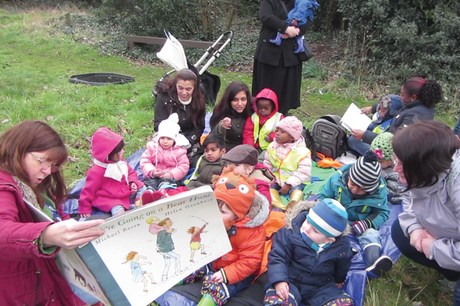
BOTTLE BABIES
‘Bottle babies’ were a huge success back at the children’s centre, and many childminders made them at their own settings. These two-litre bottles contain coloured water, along with glitter or other tiny objects that float about when the bottles are moved. Bottle babies are a cheap, open-ended resource that supports schematic and physically active play, and adults and children alike adore them.
Ms King recognises that to sustain the enthusiasm for physically active play, she will need to continue supporting the childminders in her patch. ‘I’m going to have to keep running outdoor sessions for the childminders, reminding them that children need physical activity and what the benefits are,’ she says.
‘I did a questionnaire with them at the start of the project, to find out what they thought the barriers were to going outdoors more, or making reluctant children more active. I based my project on their answers, so I plan to revisit the questionnaire to get new childminders involved and find out what the longer-term improvements have been for the children of the first set of minders I worked with.’
‘GRAB AND GO’ KITS
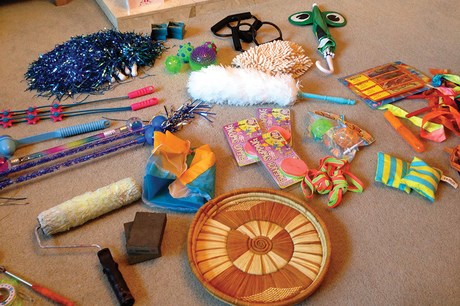
One of the most successful projects the Outdoors and Active childminders and childminding co-ordinators tried was a range of simple, lightweight resources that could be carried easily to the park, the shops, on short journeys and in the garden.
Containers
They also tested several types of container for their Grab and Go kits to establish which worked best for childminder and family lifestyles, and these included:
• small, lightweight, water-resistant backpacks
• change-bags to go over pram handlebars, or a tidy box to go in the storage basket
• flat-pack plastic baskets, or shopping bags on wheels – pushing or pulling this to the park would be a good physical activity for children in itself
• in the setting or at home, a small suitcase or tidy box on wheels.
Resources
The resources were tested and chosen for being easily portable, while still being robust enough for active play. Using Jasmine Pasch’s ‘Boing Whoosh RolyPoly’ approach, childminders scoured charity shops, pound shops, jumble sales, DIY stores and supermarket toy shelves for:
• long lengths of wide elastic, tied at the ends for jumping, pulling, stretching
• light, washable or wipe-clean bean bags for throwing and catching
• clothes pegs and clips, tent pegs and old sheets for den-building
• small picnic blanket for dens and snack time
• small multi-coloured parachute for windy-day and ball games
• silky, satiny, flowy scarves for whooshing through the park with
• chunky chalks for making trails, mark-making and pictures
• water squirters for water fights and mark-making
• small lengths of string, twine and rope and paracord to make dens, trails and tree swings
• tennis balls, squashy and textured rubber balls, balls that make a noise when bashed
• cheerleader shakers and pom-poms
• gymnastic twirling ribbon wands
• clear plastic umbrellas for fun in the rain
• back scratchers and massagers.
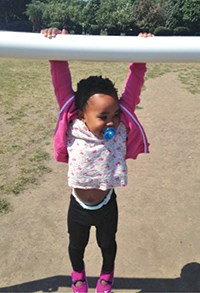 WHAT PARENTS AND CARERS NEED TO KNOW
WHAT PARENTS AND CARERS NEED TO KNOW
The Outdoors and Active childminding co-ordinators and childminders researched the barriers to more active play beyond the setting, and devised a series of principles and facts that parents and carers need to understand in order to embrace and sustain a physically active lifestyle for their children:
• A common sense, measured approach to risk-taking in outdoor play. Parents are naturally fearful of injury to their child, but we need to help them understand and weigh up the benefits of physically active outdoor play as well as the risks. The likelihood of injury is a question that’s often omitted, with parents considering the ‘worst case scenario’ instead of keeping children as safe as necessary. A ‘risk benefit’ prompt sheet for practitioners and parents can be downloaded at www.nurseryworld.co.uk.
• The hard-wired relationship between physical movement and the developing brain. Babies are born with the vestibular system in place and sitting still is not desirable or even possible in young children: the movements they make are building connections in their brain, organising it into higher-order thinking skills. The child who is unable to sit still needs more opportunities to play physically, not fewer, since the ability to sit still is dependent on muscle control as well as posture and balance. Outdoors is the perfect place to work on managing both voluntary and involuntary movements.
• The physical development journey children must travel in order to gain a strong tripod grip. The Outdoors and Active researchers tried writing a whole paragraph with their non-dominant hand, quickly finding it difficult and uncomfortable. The muscles in our fingers, wrists, forearms, shoulders and back must work together to enable the tripod grip – or cutlery grip, or handhold grip. A child who lacks opportunities to make big, sweeping, robust, playful movements will find holding a pencil much more difficult than the child who swings from the monkey bars, carries awkward tree branches and rolls and spins down a grassy hill. These movements build strength, co-ordination, flexibility and control in the large muscle groups in the upper back and shoulders, and without them, children will struggle to write.
• Why repetitive movements are good.Repetition strengthens the neural pathways that physical movement is creating between body and brain, and we should try to avoid telling children to ‘stop doing that’, instead finding time and space to allow children to make the repetitive and often noisy body movements that their brain is demanding.
• Every movement counts. While the British Heart Foundation recommends children engage in at least three hours of physical activity every day, every movement really does count – so taking the stairs instead of the lift, walking to school, parking further away from the shops and calling by the park on the way home are all excellent ways to raise children’s heart rate, get them ‘puffed out and rosy cheeked’ and build stamina.
MORE INFORMATION
• The Well Balanced Child by Sally Goddard Blythe (Hawthorn Press, 2014)
• Exercising Muscles and Mindsby Marjorie Ouvry (NCB, 2003)
• A Moving Child is a Learning Child by Gill Connell and Cheryl McCarthy (Free Spirit, 2014)
• 50 Fantastic Ideas for Physical Activity Outdoors by Alistair Bryce-Clegg (Featherstone, 2013)
• Health and Safety Executive: High Level Statement – Striking A Balance, www.tinyurl.com/HSEplay
• University of Essex’s Green Exercise Research programme, www.greenexercise.org


